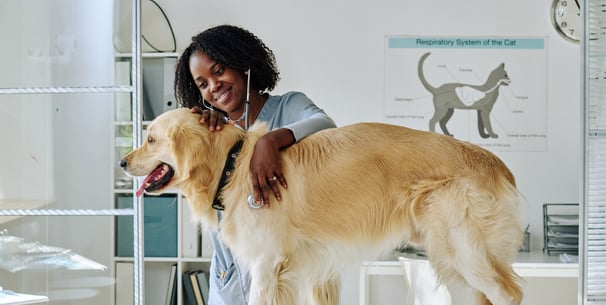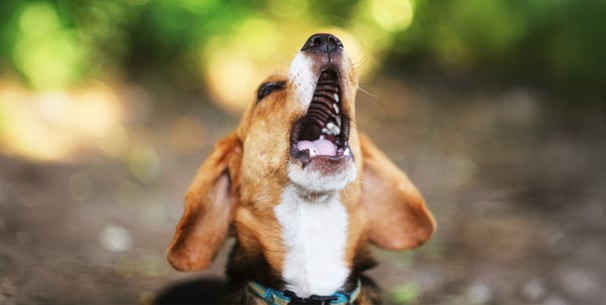Is My Dog in Season? Symptoms, Dog Heat Cycles, and What to Do
Index:



Introduction
Worried your female dog is acting a bit odd?
Perhaps she’s leaving little spots on the carpet, or suddenly every male dog in the park is giving her the eye.
If you’re feeling a bit lost, you’re not alone! The heat cycle can be confusing, messy, and even a tad stressful for both you and your pet.
But don’t worry—we’re here to guide you through the ups, downs, and tail wags to deal with a dog in heat.
Let’s make this season a little less rough for everyone.
Key takeaways
A dog in season is a natural process which happens to all unspayed female dogs.
Signs include swelling of the vulva, dog bleeding, and changes in behaviour.
The heat cycle usually lasts about three weeks and occurs twice a year.
Your dog may become pregnant if not carefully managed during this time.
Dog nappies and extra walks can help keep your home and pet clean.
Speak to your vet if you notice anything unusual or if your dog has irregular seasons.
Neutering your dog is the only way to prevent unwanted litters.
Every dog is different—some dogs bleed heavily, others barely at all.



Understanding what a dog in season means
When your female dog is in season, she’s experiencing her reproductive cycle—a bit like a canine version of a period, but with more sniffing and less chocolate.
This is the time when female dogs come into heat and can become pregnant if they meet an eager male dog.
The first heat usually arrives at around 6 months old, but smaller dog breeds tend to come into season earlier than larger ones.
Signs your dog is in heat
Recognising the signs your dog is in heat can save you a lot of guesswork (and carpet cleaning). Here’s what to look for:
Swollen vulva (it may look a bit like she’s sat on a bee—don’t worry, it’s normal!)
Dog bleeding or spotting, especially within the first few days
Licking her back end more than usual
Flirtatious behaviour towards other dogs
Restlessness or being a bit confused during her season
Sudden interest in every male dog in the neighbourhood
Trying to escape the garden (the grass is always greener—and so are the suitors)
If you notice any of these, your dog is likely in her first season or in another heat cycle.



The stages of the heat cycle
The dog’s heat cycle is split into four main stages. Here’s a quick comparison:
During oestrus, your female dog is fertile and can get pregnant.
This is when you’ll need to be extra vigilant—unneutered male dogs can smell a female in heat from miles away (or at least, it feels that way).
How often do dogs go into heat?
Most dogs go into heat twice a year, but this can vary. Smaller breeds might go into heat twice or even three times, while larger breeds may only come into heat once a year.
The cycle lasts about 2–3 weeks, but the signs of a dog in heat can be subtle or dramatic—every dog is different.



What to do when your dog is in heat
So, your dog is coming into season—what now? Here’s how to care for your dog and keep your sanity:
Keep your dog on a lead during walks to avoid surprise romances.
Use dog diapers/dog nappies or washable pads to manage dog bleeding.
Give her extra cuddles—she will be feeling hormonal and may need comfort.
Distract her with toys and mental stimulation
Avoid dog parks or busy areas with lots of male dogs.
Watch for signs of distress or illness—speak to your vet if you’re worried.
Remember, some dogs can become a bit moody or clingy. Others act like nothing’s happening at all.
If your dog gets especially anxious, working with a professional trainer can help. If you're a Waggel member, why not book a free behaviour consultation with Companion Animal Wellness? It's included in your policy!
Preventing your dog from getting pregnant
If you’re not planning on letting your dog have a litter of adorable (but exhausting) puppies, preventing them from getting pregnant is key.
The only foolproof method is neutering your dog—also known as getting your dog spayed.



Common questions about dogs in heat
Here’s a quick list to help answer those burning questions:
How long is a dog in heat?
Usually lasts 2–3 weeks.
Do dogs bleed heavily?
Some do, some don’t—every dog is unique.
Can dogs have longer or shorter cycles?
Yes, especially as your dog gets older.
What if my dog has irregular seasons?
Speak to your vet for further guidance.
Can my dog get pregnant during her first heat cycle?
Yes—dogs have their first fertile season at around 6 months.
Should I let my dog mate?
Only if you’re prepared for puppies and have done your research.
When to speak to your vet
While most dogs come into season without trouble, sometimes things go awry.
If your dog starts showing signs of illness, bleeds heavily, or seems in pain, it’s time to speak to your vet.
Also, if your dog’s first heat hasn’t arrived by 18 months, or if her cycle lasts much longer than usual, get her checked.



Should you get your dog spayed?
Neutering your dog not only prevents unwanted litters but can also reduce the risk of certain cancers and infections.
It’s a big decision, so chat with your vet about the best timing—often within the first few days after a season, but every dog is different.
If you’re considering pet insurance to help with vet costs, see our guide to pet insurance.
Wrapping up
Navigating your dog’s heat cycle can be a challenge, but you don’t have to do it alone.
For peace of mind, expert advice, and cover for unexpected vet bills, get a Waggel Pet Insurance quote today.
Your dog deserves the best care, so let’s make every season a little easier, together.
Waggel Pet Insurance
Need more help? You're in luck if you're a Waggel Pet Insurance member. Along with our excellent coverage, we offer access to a 24/7 online vet to answer all your sticky questions, especially if you need grooming assistance.
Not a member? Why not get a quote now and cover your furry friend for a range of illnesses, all while enjoying our amazing perks and rewards.
Want more like this?
Get updates from us with helpful info, advice, answers to frequently asked questions and much more.
Index:
- Introduction
- Understanding what a dog in season means
- Signs your dog is in heat
- The stages of the heat cycle
- How often do dogs go into heat?
- What to do when your dog is in heat
- Preventing your dog from getting pregnant
- Common questions about dogs in heat
- When to speak to your vet
- Should you get your dog spayed?
- Wrapping up
Related posts:
Get your quote
Along with our excellent coverage, we offer access to a 24/7 online vet to answer all your sticky questions.





